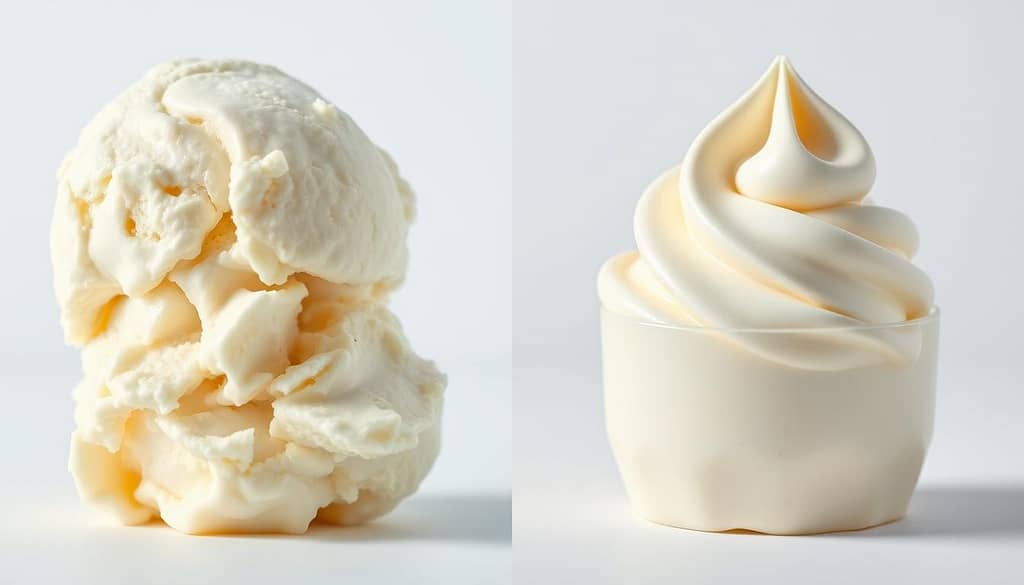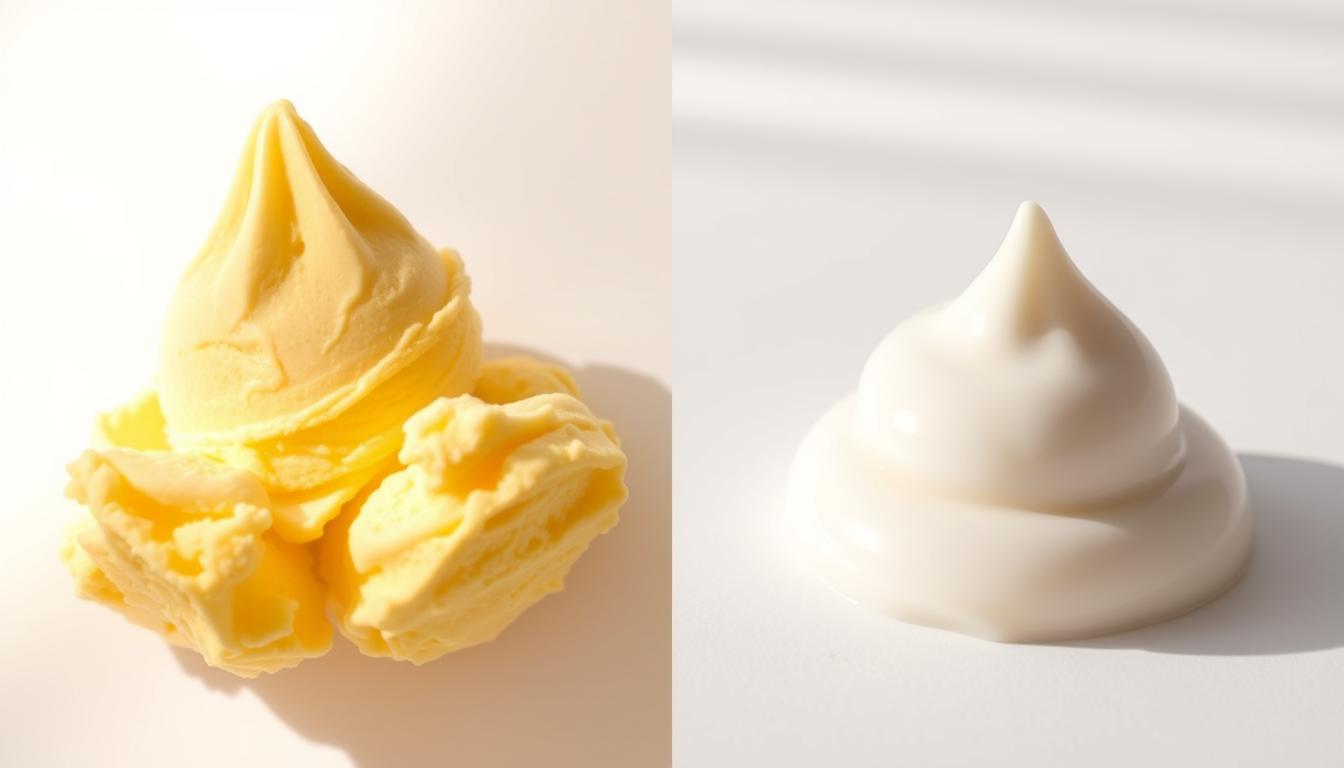Ever wondered why some treats are called ice cream while others are frozen dairy desserts? It’s because of legal standards and ingredients. This guide will explain the history, rules, and main differences between these frozen treats.
The FDA says ice cream must have certain milkfat and air levels. Frozen dairy desserts, on the other hand, might use less fat or additives. Knowing these differences helps you pick the right treat for you.
Key Takeaways
- Frozen dairy dessert vs ice cream classifications depend on milkfat and ingredient rules.
- Ice cream must meet strict FDA requirements for cream and overrun levels.
- Frozen dairy desserts allow more flexibility in ingredient choices.
- Both categories offer unique textures and nutritional profiles.
- Label reading helps identify which product you’re actually buying.
Introduction to Frozen Dairy Desserts and Ice Cream
Ever seen “frozen dairy dessert” on a label and thought it was ice cream? It’s not quite the same. Legal and ingredient rules make them different. Let’s dive into what sets them apart.

What Are Frozen Dairy Desserts?
These creamy treats don’t follow strict USDA ice cream rules. They might use less milkfat or add sweeteners and stabilizers. Brands like So Delicious or Arctic Zero fall into this category. This lets them offer low-fat or diet-friendly options.
What Is Ice Cream?
Ice cream must have at least 10% milkfat by USDA standards. It’s made with cream, sugar, and dairy. Churning traps air for a rich texture. Brands like Ben & Jerry’s or Haagen-Dazs are examples. Their higher fat content makes them smoother and denser.
Now you know the basics. Next, we’ll look at how history shaped these treats. But remember, labels are important. A “dairy dessert” tag means it’s not ice cream, even if it tastes similar.
The History Behind Your Favorite Frozen Treats
Imagine enjoying a scoop of gelato or a spoonful of kulfi. These treats have a rich history. Let’s explore how frozen desserts evolved from ancient luxuries to today’s favorites.
Centuries ago, frozen treats history started in frozen dessert origins around 200 B.C. in China. Emperors loved iced milk drinks. By the 7th century, Persians made sharbat by mixing snow with fruit and honey. This was a step towards modern sherbets.
When Marco Polo brought these ideas to Italy, they became creamy gelato by the 16th century.
“The first Italian ice cream shops appeared in Florence, changing dessert forever.”
In 17th-century France, King Louis XIV’s court loved icy desserts. This made frozen dessert origins spread across Europe. By the 1800s, mechanical refrigeration made these treats available to everyone.
Today, we see global traditions like India’s Kulfi. It’s slow-churned for a rich texture. Next time you enjoy a cone, think about the stories of emperors, explorers, and inventors from across the ages.
Exploring Dairy Ingredients and Fat Content
Dairy ingredients and fat content are key in frozen treats. They decide if a dessert is smooth or light, rich or cool. Let’s see what makes each treat special.
Ice cream must have at least 10% milk fat to be called ice cream. Frozen dairy desserts have less fat, making them softer. Here’s how these parts work together:
Common Dairy Ingredients
- Milk: Adds liquid base and natural sweetness.
- Cream: Supplies fat for creaminess and richness.
- Sugar: Balances flavors and lowers freezing points.
- Stabilizers: Like guar gum, they keep textures smooth.
Understanding Fat Content
More fat means a treat is velvety, while less fat makes it lighter. For instance, ice cream’s fat from cream makes it melt in your mouth. Frozen dairy desserts use skim milk or reduced-fat creams to meet legal standards.
Now, we’ll see how these choices affect treat making. We’ll find out why some melt faster than others. The science behind every bite begins here.
Manufacturing Processes That Differentiate Each Treat
The way frozen treats are made shapes every bite you enjoy. The manufacturing process decides if you’re biting into dense, premium ice cream or a lighter dessert. A key factor is overrun, the air whipped into the mix during production.
Exploring Overrun in Frozen Desserts
Overrun measures the volume increase from added air. Ice cream must stay under 100% overrun per FDA rules, doubling its volume. This ensures richness. Frozen desserts often use higher overrun—up to 150%—making them fluffier and cheaper.
“Overrun directly ties to cost and texture,” note industry experts, highlighting its role in balancing affordability and indulgence.
Quality Manufacturing Steps
Quality steps include:
- Pasteurization to ensure safety
- Careful blending of ingredients
- Churning with controlled overrun levels
- Aging the mix to enhance creaminess
- Freezing in specialized equipment
Premium brands focus on low overrun for density. Economy products use higher overrun to stay budget-friendly. Every step from mixing to packaging matters, turning liquid into the treat you love.
Texture and Flavor: What Sets Them Apart
Ever notice how a scoop of ice cream feels velvety, while sorbet feels crisp? Texture and flavor define these treats. Let’s break down what makes each unique.
| Type | Texture | Flavor Profile |
|---|---|---|
| Ice Cream | Smooth, dense | Sweet, with chocolate chips or swirls |
| Sorbet | Granular, icy | Sharp fruit flavor without dairy |
| Frozen Yogurt | Light, airy | Sour dairy notes, customizable toppings |
Ice cream’s texture comes from cream fat. Sorbet’s icy crunch is from fruit puree. Frozen yogurt’s flavor balances tanginess with mix-ins like caramel sauce.
“A dessert’s flavor is only half the story—texture completes the experience.” – Culinary Science Journal
- Ice cream: Chunky Monkey’s cookie pieces add crunch
- Sorbet: Dolce & Gabbana’s lemon sorbet has bright citrus flavor
- Frozen Yogurt: TCB Yogurt’s yogurt base offers a tangy bite
Next time, choose based on your mood: creamy texture for indulgence or a tart flavor for a light treat.
Navigating Nutritional Value and Health Considerations
Choosing between frozen dairy desserts and ice cream? Knowing their nutritional value is key. Both have different amounts of calories, fats, and sugars. Let’s look at what’s important.
Calories and Macronutrients
Ice cream tends to have more calories because of cream and butterfat. A half-cup of premium vanilla ice cream has 250–300 calories, 14g fat, and 18g sugar. Frozen desserts, on the other hand, usually have less than 150 calories and 3g fat. Always check the labels for exact numbers:
- Ice cream: Look for brands like Ben & Jerry’s that list full nutritional breakdowns
- Frozen desserts: Halo Top advertises 90–120 calories per serving
Diet-Friendly Options
There are smart choices for every diet. Consider:
- Low-sugar options like So Delicious Coconut Milk Frozen Dessert (only 6g sugar per serving)
- Protein-packed picks like Enlight Ice Cream, which adds 5–7g protein
- Dairy-free alternatives made with almond milk or coconut oil
Choose treats with real ingredients like fruit purees over artificial additives. Enjoy small portions with meals high in fiber. Your choices have an impact—so enjoy them mindfully!
Labeling Regulations for Frozen Dairy Desserts and Ice Cream
Labeling rules make sure you know what you’re buying. Federal laws like FDA rules have strict rules for milk fat and ingredient lists. When you shop, these rules help you tell ice cream from its lighter versions.
Understanding Legal Labeling Requirements
| Product Type | Milk Fat Minimum | Labeling Rules |
|---|---|---|
| Ice Cream | ≥10% milk fat | Must use “ice cream” only if meets fat standards |
| Frozen Dairy Dessert | Must clarify “frozen dessert” to avoid mislabeling |
These labeling regulations also require clear lists of sweeteners and additives. Look for terms like “non-dairy” or “reduced-fat” to know it’s not traditional ice cream.
- Check milk fat percentage to gauge creaminess
- Verify “ice cream” claims match legal definitions
- Spot “frozen dessert” labels for lower-fat options
Companies must follow these rules to avoid fines. Always check labels to meet your dietary needs—whether you prefer rich ice cream or lighter options.
Decoding Food Safety Standards in Your Treats
Every batch of frozen treats you enjoy starts with rigorous food safety standards. Manufacturers follow strict protocols to keep your desserts safe from production to your freezer. Here’s how they do it:
- Temperature control: Freezers maintain -20°F or colder to halt bacteria growth during storage.
- Regular testing: Labs check for contaminants like listeria and salmonella in every production batch.
- Staff training: Workers wear protective gear and sanitize equipment before handling ingredients.
Even packaging matters. Sealed containers prevent contamination during shipping. “Proper handling at every step ensures safety without sacrificing taste,” says a USDA food safety guide.
Look for seals like NSF certification on labels. These standards mean you can trust your dessert’s quality—from artisanal brands to supermarket favorites. Next time you scoop a bowl, know science and regulations work together to keep your treat safe and enjoyable.
Environmental and Ethical Manufacturing Trends
Today, frozen dessert makers are changing how they make your favorite treats. They focus on eco-friendly packaging and fair labor practices. This balance of taste and responsibility shapes what you find in your freezer.
Sustainable Practices
Many brands are now using sustainable practices to lessen their impact. They use eco-friendly packaging like plant-based cartons. Some even run on renewable energy to cut carbon emissions.
Ben & Jerry’s uses 100% recycled materials for their pints. They also save water with closed-loop systems, keeping quality high.
Ethical Sourcing of Ingredients
Every spoonful has a story behind it. Ethical sourcing means ingredients like cocoa or vanilla are grown right. Look for brands that work with fair-trade certified farmers.
Häagen-Dazs supports cocoa farmers through the Cocoa Life program. A 2023 study found 68% of U.S. consumers want brands with clear supply chains.
“We’re committed to ingredients that respect people and the planet.” — Ben & Jerry’s 2023 Sustainability Report
When you shop, look for labels with regenerative agriculture or carbon-neutral shipping. These small choices make a big difference in how frozen treats are made.
Smart Shopping Tips for Frozen Desserts
Walking the frozen aisle can feel overwhelming. But, a few simple steps make choosing the best treats easy. Let’s break down how to spot quality frozen desserts without the guesswork.
How to Read Labels
Flip the container and check these details:
- Ingredients list: Look for dairy first, like milk or cream, and minimal artificial additives.
- Nutrition facts: Compare calories and fat content to match your dietary goals.
- Allergen warnings: Look for clear calls-outs for common allergens like nuts or soy.
| Label Element | Ice Cream | Frozen Dairy Dessert |
|---|---|---|
| Minimum Fat Content | 10% or higher | Under 10% |
| Sweetener Types | Sugar, cane syrup | May use alternative sweeteners |
| Volume | Denser texture from higher overrun | Lighter, fluffier texture |
What to Look for in Quality
Quality shines through in three key areas:
- Texture cues: Check for smoothness (no icy crystals) and consistent density.
- Certifications: Seek USDA grades or non-GMO project seals for added trust.
- Brand transparency: Choose companies sharing sourcing details for dairy and additives.
“The first line on the label tells the biggest story—prioritize real dairy ingredients first,” says the International Dairy Foods Association.
With these tricks, you’ll find treats that satisfy cravings while aligning with your preferences. Always scan the front packaging for “ice cream” vs. “frozen dessert” claims to avoid confusion.
Seasonal and Cultural Consumption Trends
Ever wondered why some frozen treats become must-haves during holidays or in certain regions? Consumption trends for desserts shift with seasons and cultural traditions. Whether it’s a summer scoop or a festive favorite, these patterns shape what you choose to enjoy.
“A scoop of gelato in Italy isn’t just dessert—it’s a cultural ritual.” – Italian culinary historian
Holiday Favorites
Winter holidays bring rich flavors like peppermint ice cream or chocolate-dipped cones. Summer sees lighter options like fruit sorbets. These choices aren’t random—they’re rooted in tradition. Imagine savoring a spiced kulfi during Diwali or a Mexican raspado on a hot day.
Regional Variations
- Italy: Gelato’s creamy texture adapts to local ingredients, from pistachio in Sicily to hazelnut in Piedmont.
- India: Kulfi’s slow-churned richness thrives in warmer climates, often spiced with cardamom or saffron.
- Japan: Mochi ice cream blends chewy rice cake with sweet fillings, a modern take on tradition.
These consumption trends highlight how frozen desserts mirror cultural values. Next time you choose a treat, think about the stories behind your choice.
Comparing Price Points and Market Dynamics
Ice cream and frozen dairy desserts have different prices. Premium brands like Haagen-Dazs are 2–3 times more expensive. This is because they use better ingredients and make them slower.
| Factor | Ice Cream | Frozen Dairy Dessert |
|---|---|---|
| Cost Per Ounce | $0.80–$1.50 | $0.40–$0.70 |
| Production Time | Longer churning cycles | Quick mixing methods |
| Market Share | Specialty stores, high-end brands | Grocery store basics |
Stores like Walmart sell their own frozen desserts for under $3 a pint. Premium brands often talk about using organic milk or cream. Always check the labels to find the best value for your money.
- Premium ice cream uses more milkfat, raising costs
- Budget options cut costs with stabilizers
- Seasonal sales boost affordability for both types
Look at the price per serving. For example, a $5 pint of premium ice cream at 16 oz has 32–48 calories per ounce. A $2.50 frozen dessert has the same volume but costs less. Pick what you like and can afford.
Understanding Patent and Industry Innovations
The frozen dessert world is buzzing with patent innovations. Companies like Nestlé and Ben & Jerry’s are racing to patent new ways to make your treats creamier, healthier, and more sustainable. Tech and creativity are shaping your next scoop.
New Dairy Technology Shaping the Industry
Recent dairy technology trends focus on efficiency and taste. Look for patents involving:
- Cryogenic freezing: Flash-freezing ingredients to lock in freshness
- 3D-printed shapes: Customizable dessert designs
- Plant-based emulsifiers: Creamy textures without dairy
These advancements cut waste while boosting flavor retention. For example, Italian startup Nocilla uses AI to optimize chocolate mix-ins for ice cream bases.
Flavor and Texture Breakthroughs
Patent filings reveal exciting flavor innovations, like:
| Technology | Example |
|---|---|
| Flavor encapsulation | Vanilla with burst-of-raspberry centers |
| Texture-modifying enzymes | Non-drip ice cream (patented by Unilever) |
“Texture is the new frontier in frozen desserts,” says a 2023 study by the International Dairy Foods Association.
Next time you grab a pint, you might find hints of matcha sea salt or chili chocolate—flavors once unimaginable. Innovations like these mean your dessert cabinet is about to get even more interesting.
Your Guide to Homemade Frozen Treats
Turning your kitchen into a dessert lab is easier than you think. With basic ingredients and a freezer, you can craft creamy treats without store-bought limits. Let’s dive into fun, hands-on recipes and inventive twists to make every batch unique.
Simple Recipes
Start with these easy steps for a base recipe:
- Mix 2 cups heavy cream, 1 cup sweetened condensed milk, and 1 tsp vanilla extract in a bowl.
- Add mix-ins like cookie chunks or fresh berries.
- Freeze in a shallow dish, stirring every 30 minutes for 2-3 hours.
Pro tip: Use dark chocolate shavings for an extra-rich finish.
Creative Experimentation
Take risks with these ideas:
- Blend in espresso powder for a mocha flavor.
- Swap cream for coconut milk for a vegan option.
- Try seasonal ingredients like pumpkin purée in fall or mint extract in summer.
“The best desserts are those where you can taste the joy of creation.” – Julia Child
Don’t fear mistakes—overripe fruit or overwhipped cream can lead to new favorites. Share your recipes online or host a tasting party. With practice, you’ll master the balance between texture, sweetness, and innovation.
frozen dairy dessert vs ice cream: A Detailed Comparison
Choosing between frozen dairy dessert and ice cream has its differences. Let’s look at the facts you can trust.
| Category | Frozen Dairy Dessert | Ice Cream |
|---|---|---|
| Milkfat Content | <10% milkfat | >10% milkfat (by law) |
| Texture | Denser, less overrun | Lighter, creamier texture |
| Labeling | Must state “frozen dessert” | Labeled as “ice cream” |
| Calories | Typically lower | Higher due to fat content |
When reading labels, look for these key differences:
- Ice cream has richer cream base
- Frozen desserts often use stabilizers
- Legal definitions matter most
Your choice depends on taste and needs. Check the milkfat percentage next time you shop!
Conclusion
Now you know the difference between frozen dairy desserts and ice cream. Frozen dairy desserts have less milkfat, while ice cream has more. Always check the labels for fat percentages and added ingredients.
Both have their own textures and flavors. Think about what you want when choosing. Do you want something creamy or lighter?
Choose brands that are good for the planet and animals. Try making your own to control sweetness and creaminess. Enjoying ice cream or lighter desserts is all about making smart choices.
Keep trying new flavors and support brands that share your values. This way, you can enjoy delicious desserts that are also good for the planet.

